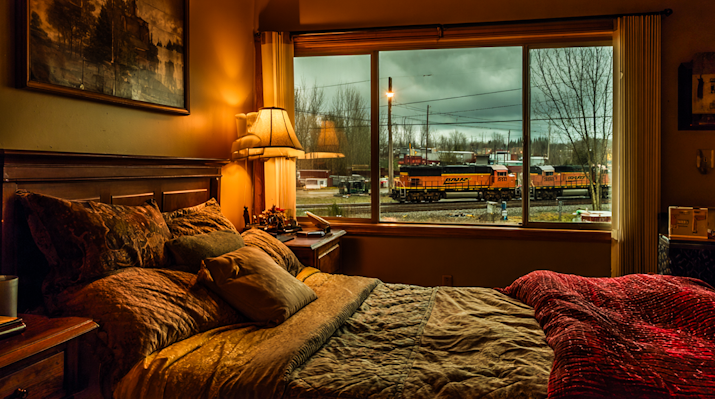It sounds charming at first. A little house near the railroad. Maybe with a picket fence, maybe with a view. But after the third 3 a.m. train horn in a week? The charm fades fast.
Living near the tracks in towns like Safford, Pima, or Thatcher means dealing with noise you can’t ignore. And it’s not just the loud blare of a passing train—it’s the rumble, the vibration, the metallic screech of brakes. Day and night.
The good news? You don’t have to pack up and move to get relief. Simple upgrades, like acoustic door seals, can make a real difference. These thick, sound-dampening strips go around the perimeter of your doors, especially the bottom, where most noise leaks in. They create a tighter seal that blocks out outside sound, even those low-frequency rumbles that shake your coffee mug. Paired with window improvements and some thoughtful changes to interior walls, they can turn a restless night into peaceful sleep.
And most of it? It’s doable without tearing your home apart or draining your savings.
Why Train Noise Is More Than Just an Annoyance
Train noise isn’t just irritating. It’s a health issue. And it doesn’t stop when the engine does.
Sleep Disruption and Health Effects
When your body can’t stay in deep sleep, everything suffers. Train noise, especially at night, causes micro-awakenings—even if you don’t remember them in the morning. Over time, this leads to fatigue, reduced focus, and even mood disorders.
Research has shown links between chronic noise exposure and higher stress levels, increased blood pressure, and even heart strain. For kids and the elderly, the effects can be even more pronounced. Your brain never gets to fully “shut off” when it’s on constant alert.
Property Values Along Railroad Lines
Whether you’re planning to sell soon or not, train noise impacts resale value. Real estate agents in Graham County know: homes within earshot of heavy freight traffic often appraise lower than similar properties just a few blocks away.
Potential buyers walk in, hear a train in the distance, and start calculating soundproofing costs or simply walk out. A well-insulated, quiet interior helps protect your investment and makes your home more marketable in the long run.
Train Schedules and Noise Patterns
To beat the noise, it helps to understand it. Train traffic isn’t random. There’s a rhythm to it—one that locals learn quickly.
In many Arizona towns, early morning and late-night trains are the worst offenders. These runs avoid heavy daytime vehicle traffic, but they ruin your REM cycle. Some freight lines rumble through at the exact same time each night—like clockwork, but louder.
Knowing your local train schedule can help you plan targeted soundproofing. Bedroom faces the tracks? Prioritize windows and walls on that side. Got a quiet period during midday? Time naps, work calls, or outdoor activities around that window of peace.
Simple Home Upgrades That Make a Difference
Total home renovation isn’t required. In fact, many residents along Railroad Avenue and similar corridors have already discovered this: it’s the small changes that add up.
Budget-Friendly Sound Blocking Solutions
Start with what you can do over a weekend. Acoustic curtains are heavy, stylish, and help dampen mid-range and high-frequency noise. Weatherstripping around windows and acoustic door seals do wonders for stopping outdoor sounds from slipping through.
Area rugs over hardwood floors help absorb vibration. Bookshelves, especially when filled, act like noise-dampening barriers on shared or exterior walls. Even rearranging furniture—like placing a tall dresser or upholstered headboard against a loud wall—can muffle sound more than you’d expect.
Professional Acoustic Improvements Worth Considering
When basic fixes aren’t enough, calling in an expert might be worth it. Acoustic panels, if installed properly, reduce echo and outside noise. Double-pane or laminated windows can drastically lower exterior sound transmission.
Contractors can even add mass-loaded vinyl (MLV) between drywall layers for serious sound defense. The investment isn’t small, but it’s still far cheaper than moving—and it’s permanent peace of mind.
What Local Homeowners Have Already Tried
You’re not alone in this. All across Graham County, homeowners are experimenting, adapting, and getting creative to fight the noise. And guess what? Many of these solutions actually work.
Success Stories from Railroad Avenue
Take Susan over on Railroad Avenue. After months of broken sleep and rattling walls, she decided to act. First step? She added thick, thermal blackout curtains in the bedrooms. Then she sealed every door with acoustic door seals, focusing especially on the back patio entrance.
The result? Noticeable change—almost immediately. The train still passed by, sure. But it wasn’t shaking her nerves anymore. “It went from unbearable to background,” she said.
Down the street, the Thompsons took it a step further. They insulated the garage wall facing the tracks with rock wool, then installed double-glazed windows in the nursery. Their baby started sleeping through the night. That alone was worth every penny.
DIY Projects That Actually Worked
Plenty of folks skipped the contractor route and did the work themselves.
One retiree used thick moving blankets to line his home office walls. Not pretty—but functional. Another neighbor layered rugs, foam tiles, and a large canvas bookshelf on a shared wall. Cost? Under $200. Effect? Huge.
These stories remind us: you don’t have to wait for perfection. Small wins matter.
Working with Railroad Companies
Sometimes, the source of the noise has to be part of the solution. And believe it or not, railroads do have systems in place for handling complaints—if you know how to approach them.
Noise Complaint Procedures That Get Results
The first step is documentation. Note the times, train types (freight vs. passenger), and specific issues—horns, idling, vibration. Keep a log for at least two weeks.
Then, contact the railroad’s public affairs or environmental division. Be specific and respectful. Reference federal noise guidelines if possible. Some companies will send out teams to assess the problem, or even adjust horn usage in residential areas.
If multiple neighbors report the same issue, the urgency goes up. Which brings us to…
Community Efforts for Quieter Operations
When a block gets organized, things happen faster. Neighborhood associations in small Arizona towns have pushed for no-whistle zones, better train schedules, and even vegetation barriers along tracks.
In one instance, a petition led to the installation of a quiet zone near an elementary school. That wasn’t an overnight fix—but persistence paid off. And the kids? They could finally focus in class.
If you’re serious about change, gather support. One voice is easy to ignore. A dozen? Harder. A whole block? That’s pressure.
Here’s the truth: train noise probably isn’t going away. But your home doesn’t have to suffer because of it. With a clear plan, smart choices, and realistic expectations, you can win the noise battle.
Planning Your Home’s Sound Defense Strategy
Start by identifying the loudest zones in your home. Bedrooms. Baby rooms. Offices. Work from the outside in. Doors, windows, vents. Then move inward to walls, floors, and ceiling gaps.
Mix low-cost upgrades with long-term improvements. Test, adjust, repeat. Keep a noise log if you want to measure your progress.
And talk to your neighbors. Share what worked. Borrow ideas. Maybe even team up on larger fixes. Because sometimes, the solution isn’t just soundproofing—it’s solidarity.










